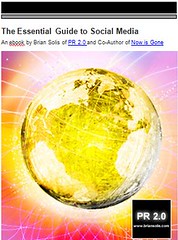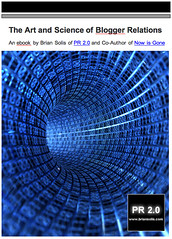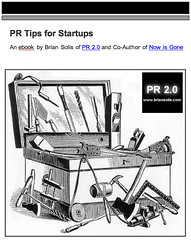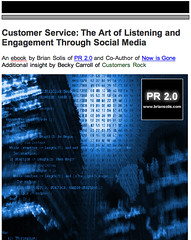The Evolution of Press Releases
There's certainly no shortage of opinions on where we are and where we need to be in order to improve the working relationships between PR and bloggers, journalists, and analysts and the brands we ultimately represent - including our own.
There are just better ways to share information, and hopefully, this post helps you.

Press releases come in different flavors and serve different purposes. Well-written press releases are far from dead. In fact, when developed strategically, their opportunities, appeal and benefits are only expanding in conjunction with the groups of various influencers and consumers who rely on them for relevant information.
The disruption of the Web has splintered press releases into a variety of formats to serve different audiences and different purposes: Traditional releases for media, SEO (search engine optimized) releases for customers, and Social Media Releases for press, bloggers, and also customers.
Customer-Focused News Releases
Companies and marketers can use distribution services to complement releases written for journalists and bloggers to reach customers directly through traditional search engines as well as news aggregation services such as Techmeme.
Over the course of the last several months, BusinessWire and PRNewswire have consistently ranked in the top 100 sources for news in Techmeme’s Leaderboard.
And, according to a recent Outsell study, over 51% of IT professionals reported that they get their news from press releases in Yahoo and Google news over trade journals.
It’s not just tech. When implemented with calls and links to action, and if they read in a way that’s compelling to people aka customers, you’ll find that they’re usually compelled to act.
The trick for this new breed of press releases is to write it as the article you want to read. Keep it clean, clear, pseudo impartial, but definitely focused on benefits for specific customers. Basically, humanize the story.
Here’s a rundown of the different formats of press releases:
Traditional Releases
Standard press releases are what many reporters and bloggers use to build their stories. Let’s help them help us in the process.
When expanding your news or story into a press release, it’s also important to recognize that a majority of the wording templates that we all use still suck. But, there’s room in our activity for a well-written release that conveys value, benefits and a story that’s relevant to each recipient. It’s easier said than done however. Most press releases are driven by product development, which begets an inward and narrowly focused view from life inside the company. The final release usually winds up riddled with adjectives, tech jargon, and hype with very little value stringing everything together.
The best releases are going to be outward-focused and reflective of the state of the market, how you fit in it, and what’s in it for the potential stakeholders (customers).
Oh, and please, can the “canned” quotes. We all know you’re excited and thrilled at whatever it is you’re announcing. But, if the quote isn’t genuinely from the person saying it and bears little or no value to the implications of the news, then it only takes away from it. It’s OK to leave it out.
I guess the best advice is to make the release read like the article that you would ultimately like to see, worrying less about structure and format and more about news, the story, and the supporting facts (and media elements) that help writers build the story more effectively. And, try to keep the release between 400 – 500 words or lower.
SEO Press Releases
Releasing press releases on wire services such as PRNewsire, BusinessWire, and MarketWire offer additional value in the form of SEM (search engine marketing). Integrating key words, phrases and embedded links optimize their “findability” and rank within traditional search engines such as Google or Yahoo. In this case, the greatest targets for SEO releases are actually customers, not journalists.
As noted previously, customers use search engines to find solutions and often, press releases provide them with the information they need to make decisions.
Many say that if you’re not on the first two pages of search results, then your company is losing the battle for online mindshare. SEO releases contribute to the authority of related search results, but keep in mind that other factors contribute as well, such as keyword buys, keywords on your Web site, affiliate strategies, as well as other tools and campaigns.
When drafting the release, ensure that your top keywords are included towards the front of the release, especially in the headline and subhead, as well as the boilerplate. Choose up to three words and repeat through the release – especially in the boilerplate. Search engines seem to pay more attention to the natural bolded words as well as the repeated words toward the top of press releases (first half).
It’s also extremely helpful to use those keywords as anchor text to link back to strategic landing pages on your Website, ensure that those pages are also keyword optimized as well. It’s important not to overuse each word or over link.
Keyword density, the number of times a keyword or phrase appears compared to the total number of words in a page, is optimized between 2-8% according to experts. I’ve erred in the middle of that ratio.
Include industry and product names and categories in place of generic descriptors such as, “the product,” “the solution,” and “the company,” throughout the release, without ruining the flow. We want to match our keywords to correlate with the real world patterns of how people search.
Also, be sure to link rich media so that your key words show up in content-specific search engines as well.
If you need help determining the best keywords for your business, here are some resources:
SEO Tools
- SEO Book (my favorite)- WordTracker
- Google AdWords Keyword Tool (my other favorite)
- Google Trends
- BlogPulse Trends
The ideal length of this release is usually sub 400 words.
Social Media Releases
You may have heard about the latest new shiny object in PR…no not Twitter, I’m talking about the Social Media Release. Originally introduced by Todd Defren in response to Tom Foremski’s call for the death of press releases, the SMR represents a new socially-rooted format that complements traditional and SEO press releases by combining news facts and social assets in one, easy to digest, and repurpose, tool.
Giving everyone what they need and how they need it, requires a different approach. Almost every press release issued today is done so without video or audio, and many still do not include links to additional information or supporting content. While these multimedia pieces are underlying components of SMRs, it’s not just about multimedia content, it’s about connecting information across social networks, the people looking for it, as well as the conversations that bind them together. And, SMRs also help bloggers and online journalists more effectively write a rich media post using one resource that provides them with everything they need.
Picture an everyday blog post, with a headline, intro paragraph, news facts, genuine quotes, and supporting market data (with links) combined with embedded socializable content, such as video from Viddler, pictures from flickr, screencasts hosted at YouTube, supporting documents piped from Docstoc, the use of social tools to bookmark, relevant tags for indexing and discoverability, subscriptions via RSS, friending company contacts via LinkedIn or Facebook, and most importantly, the ability to take compartmentalized components of the SMR to use as building blocks for a new story (embed codes).
SMRs can also include other social elements such as trackbacks, the ability to track and host comments, and also they’re findable within social media search engines such as Technorati, Google Blog Search, BlogPulse, Yacktrack, and Ask Blog Search.
Like SEO releases, SMRs also offer a new and perhaps unforeseen benefit. Much in the same way that SEO releases provide assistance to customers seeking solutions through search, SMRs offer similar benefits through social channels. The difference is, how people interact with it, discover it and also the tools they use to share and re-broadcast it.
Basically a Social Media Release should contain everything necessary to share, discover, and retell a story in a way that is complementary to your original intent and context.
Social Media Releases should not cross the wire though. They should, however, be hosted on a specific company blog channel dedicated to SMRs in order to complement traditional releases, SEO releases, company blog posts, and all other outward focused communications. Any customizable blogging platform will more than serve as an effective, and social, platform. Note, that a traditional web page isn’t necessarily social, so any published SMRs on a standard Web site will most likely not appear in social search.
My personal “secret” on SMRs is to create a fully dressed up social release under a private, non-indexed URL to share with key contacts in advance of the announcement. This gives bloggers and journalists everything they need to create an online story while minimizing the need to force additional research. Once the news is public, the SMR goes live with links to the traditional and SEO releases, company blog posts and in turn each also link back to the SMR. Also, wherever the social content is hosted, i.e. YouTube, Flickr, Scribd, Utterz, etc., should link to the SMR in order to create a seamless conversation bridge.
Click here for everything you ever wanted to know about SMRs and more.
In regards to all of the releases above, there is a note of caution however, the same tools that help you expand visibility, can also set up for failure. Wire services only edit for typos, not for content. This means that you can publish a release riddled with hyperbole, spin, buzzwords, and hype that will only serve to confuse and dissuade your customers from doing business with you. It will send them to your competition.Connect with me on Twitter, Jaiku, LinkedIn, Pownce, Plaxo, FriendFeed, or Facebook.
social+media+release social+media social media release smr smpr pr press+release brian+solis techcrunch pr+2.0 pr2.0 media+2.0 media2.0 2.0 public+relations publicity news+release news press communications blogger+relations blogger blog socialmedia hrelease seo search












3 Comments:
Brian, not having a background in PR I find this information very, very helpful. Thanks for taking the time to share your wisdom and insight.
May I make a request? I'd love for you to weigh in on the controversy taking place over at MarketingProfs with a post Mack Collier wrote about the animosity that seems to exist between bloggers and PR firms which results in one or the other being blacklisted.
I don't mean to imply that you should leave a comment necessarily. Rather, I'd love to see you compose a post which addresses the matter and which brings some badly needed perspective. I hope you'll consider it.
Again, great post!
Hi Brian
Thanks for the mention. :)
The link to SEO Book has a ; in it.
cheers
aaron wall
Brian
Thanks for you article, I've passed it on to several of my clients as a useful quick guide to the new PR landscape. Some people are claiming the early death of PR, others are saying its been waiting for social media:
http://press20.blogspot.com/2008/05/changing-face-of-modern-pr.html
However, one issue I think deserves more coverage is in the use of content other than copy (e.g. audio and especially video). Although you mention
Also, be sure to link rich media so that your key words show up in content-specific search engines as well
I feel that the increasing use of web-delivered video to capture eyeballs & brain cells will lead to a multi-media press release.
http://press20.blogspot.com/search/label/video%20press%20release
Feeback welcomed
Hayden
Post a Comment
<< Home